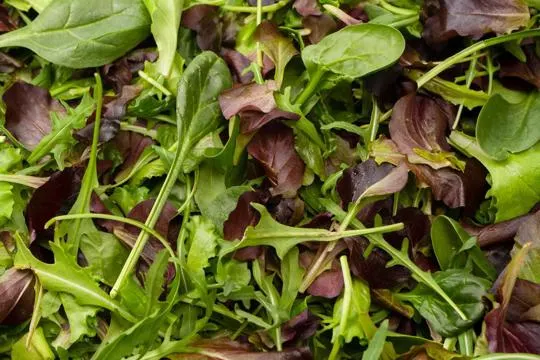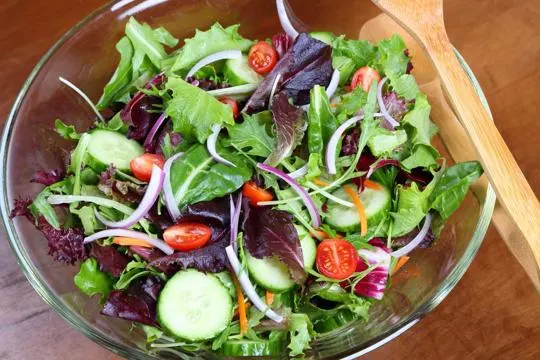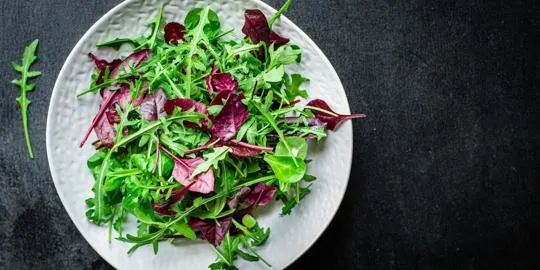In the battle of the leafy greens, there’s a showdown that even the most ardent salad fans might scratch their heads over. Mesclun versus Spring Mix. Seems like a trivial puzzle, right? Yet, here we are, drawing lines in the garden dirt.
Mesclun, a fancy term that barely rolls off the tongue, has roots in France. It’s a diverse crowd of young leaves, think peppery, sweet, and everything in-between. Spring Mix, on the other hand, is the chill cousin. It’s what you find in pre-packed salads, a blend that promises no bitter surprises.
We’ve all been there, standing in the produce aisle, pondering this very conundrum. Our salads depend on it. This isn’t just leafy greens we’re talking about; it’s the foundation of our lunch.
What is Mesclun?

Mesclun is no ordinary salad mix.
It’s a culinary treasure that adds color and flair to any dish.
A delightful blend of baby lettuces creates a taste symphony in each bite.
This mix traces back to Provence, France, where farmers hand-picked the young greens.
Mesclun is now an everyday gourmet essential.
It takes pride in its diversity.
Arugula, butter lettuce, spinach, radicchio, chicory, endive – each bring something special.
The mix also varies by region and season.
It may include fragrant herbs, pansies, or nasturtiums.
Mesclun offers countless possibilities for your meals.
What is Spring Mix?

Spring mix? Delightful.
A combination of baby greens that brings freshness.
Usually lettuces like spinach, arugula, frisée, and radicchio.
Carefully selected for their flavors and textures – a harmonious mix of color and taste.
Perfect for salads or sandwiches.
Versatile, too.
It’s mild flavor goes with a wide range of ingredients – perfect for endless culinary possibilities.
Toss with vinaigrette, add to wraps for crunch, or use as a bed for grilled veggies or seafood.
What sets spring mix apart? The young, tender greens.
Harvested small and delicate for maximum flavor and tenderness.
Packed with vitamins A and C, plus antioxidants.
Plus, it’s beautiful.
Its vibrant hue creates an eye-catching presentation.
Different leaf shapes add interest and texture.
Reach for spring mix next time you want to liven up a dish.
With its delicate taste, nutrients, and beautiful presentation, it’s sure to impress.
Happy cooking.
Differences Between Mesclun and Spring Mix

Mesclun and spring mix – two types of salad greens, but with differences.
Composition of Greens
Greens have a crucial role in our diets.
They give essential nutrients and help us to be healthy.
Each type of greens has its own flavors and textures.
Knowing their composition helps us to pick the right type for our dishes.
Mesclun and spring mix are two salad greens used interchangeably.
But, they have different compositions.
Mesclun usually consists of young lettuce leaves such as oak leaf, mizuna, arugula, and radicchio.
These greens offer a soft and mild flavor, perfect for light salads or as a bed for more intense toppings.
Spring mix is a mix of baby lettuces such as green leaf, red leaf, spinach, and chard.
This blend has a wider range of flavors and textures.
Spinach gives an earthy taste, and chard adds a slightly bitter flavor.
Spring mix goes with both sweet and savory ingredients.
Mesclun and spring mix may contain edible flowers or herbs such as dandelion greens or parsley to make the flavor profile more intense.
Both greens are packed with vitamins, minerals, antioxidants, and dietary fiber.
Eating these nutrient-rich greens can help with digestion, weight management, heart health, and immunity.
Flavor and Texture
Mesclun has a mixture of mild, nutty, and earthy flavors.
Its tender leaves bring a delightful crunch.
Spring mix, on the other hand, has a variety of flavors.
Arugula brings a peppery taste and mustard greens a tangy one.
Its texture is more robust with crisp and hearty leaves.
Each blend has its own uniqueness, adding flavor and complexity to salads and dishes.
Regional Variations
Mesclun and spring mix salads vary by region.
Each area has its own special mix, giving each a unique flavor.
In the Mediterranean, mesclun mixes spicy arugula, tender lettuce, and bitter chicory.
Midwest spring mix includes baby greens like spinach, butter lettuce, and mizuna.
This regional variation allows for a diverse culinary experience and caters to different tastes.
Similarities Between Mesclun and Spring Mix

Mesclun and Spring Mix differ in some ways, yet also have much in common.
Both are types of salad greens that include a blend of lettuce leaves like arugula, spinach, frisée, and radicchio – selected for their tenderness and flavor.
These salads are versatile.
They can be the base of various salads, or even served as a side dish.
Their mild, distinct flavors match a wide range of ingredients, making them a favorite among chefs and home cooks.
Health-wise, they’re both great.
Mesclun and Spring Mix are loaded with vitamins, minerals, and antioxidants.
They provide essential nutrients, such as vitamin A, C, folate, iron, and potassium.
Eating these greens can help boost immunity, aid digestion, and maintain healthy skin.
Plus, they look amazing.
The varied colors and textures create an attractive presentation, adding sophistication to dishes.
Mesclun usually has European salad greens, such as chicory or dandelion.
Spring Mix often includes lettuces like oak leaf or red leaf.
However, ingredients may vary depending on region or personal preference.
Popular Uses and Culinary Applications
Mesclun and spring mix are two popular salad blends.
But they are different.
Mesclun comes from France.
It’s made up of tender greens, like arugula, spinach and lettuce.
It’s usually used as a base for salads or as a bed for grilled food.
Spring mix is a blend of baby lettuces and other delicate greens.
It’s mild and sweet.
Perfect for light salads or as a garnish.
Both add texture and flavor.
So, use your creativity.
Mesclun is often eaten raw in salads.
Different leaf types create a balanced flavor.
It’s great with vinaigrettes and creamy dressings.
Spring mix has a milder taste.
It’s good for people who don’t like strong tastes.
And it’s not just for salads.
You can add it to soups, omelettes, etc.
Availability-wise, mesclun is seasonal and made using traditional French methods.
Spring mix is commercially grown and available year-round.
How to Store Mesclun and Spring Mix?
Keeping Mesclun and Spring Mix fresh is key.
Here’s a 5-step guide to help you:
- Wash it: Rinse with cool water, being careful not to damage the leaves.
- Dry it: Use a salad spinner or kitchen towel to pat it dry.
- Store in an airtight container: Put in a clean & dry container.
- Refrigerate: Between 32°F (0°C) and 40°F (4°C). Keep away from smelly foods.
- Use within a few days: For optimal freshness and flavor.
Plus, put a paper towel in the container to absorb excess moisture.
This will help your greens last longer.
Follow these steps and you’ll be able to enjoy vibrant salads and dishes for an extended period.
Conclusion
To summarize, mesclun and spring mix are both great choices for a healthy and delicious salad to add to your weekly meal routine.
Between the two, mesclun has stronger flavors due to the unique blend of greens used such as purple tinged endives, wild mustards, garden lettuces and imported cress.
On the other hand, spring mix offers more variety in its blend of leaves from baby arugula to various teardrop shaped lettuces.
The great thing is that you can make use of both blends in different salads to cater for the taste preference you desire.
Furthermore, with the rise demand in organic products marketed today, there is a vast selection of pre-packaged mesclun and spring mix with locally sourced ingredients tailored just for you.
So explore these options available near you and get creative with your salads today.

Leave a comment